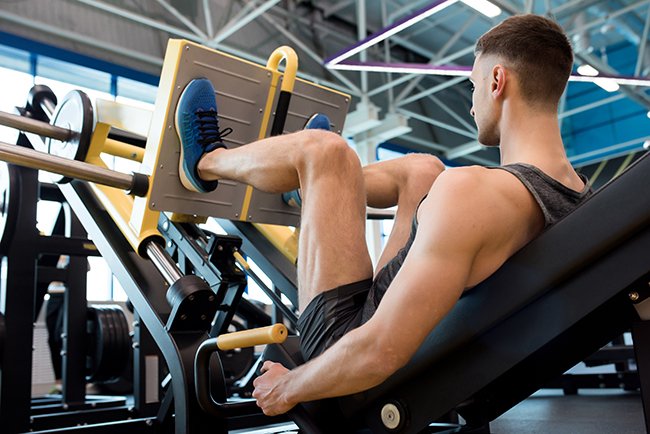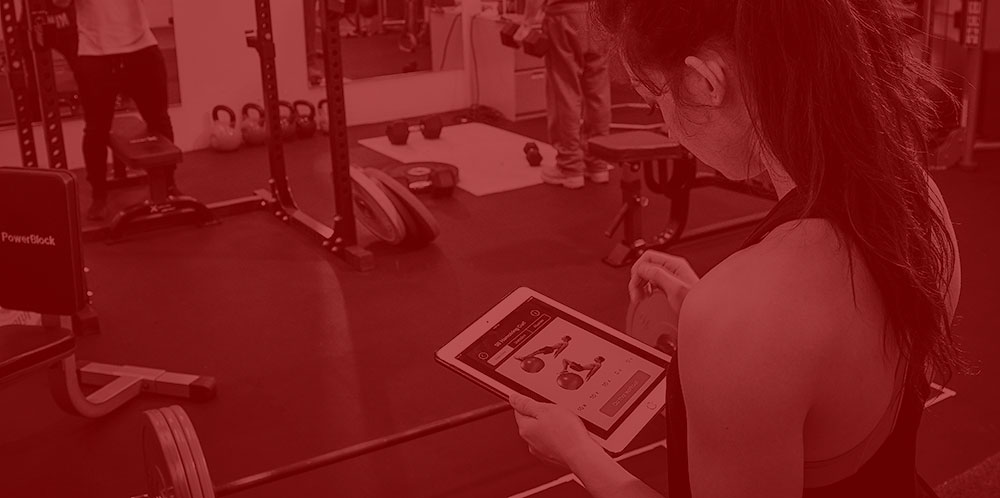
Eccentric Training = Better Results, Less Work

Most people like the idea of getting better results with less work. Eccentric training is one way to do this. Research show that focusing on the eccentric, or lengthening, phase of a lift will produce superior hypertrophy, strength, and power—if you program properly.
To ensure everyone is on the same page, here are definitions related to the phase of muscle contractions:
The eccentric phase of a lift occurs when a muscle lengthens. This is the down motion of the bench press, biceps curl, or squat.
The concentric phase of a lift occurs when a muscle contracts and shortens, as in the up motion of the bench press, biceps curl, or squat.
The isometric phase of a lift is when a muscle contracts but no movement occurs, such as during a plank when you hold yourself in a static position.
There are several interesting differences between concentric and eccentric muscle motions besides whether the muscle is contracting or lengthening.
First, you are as much as 1.75 times stronger during the eccentric motion than the concentric phase. This is why you can lower more weight in the bench press or deadlift than you can raise. As such, to overload a muscle eccentrically you must use a longer eccentric contraction or use more weight than you can lift concentrically.
Second, the eccentric motion of an exercise is when the most muscle damage occurs. Conversely, concentric training leads to negligible muscle damage and therefore rarely leads to muscle soreness, which can be useful for athletes who need to avoid getting sore for competitions.
Third, eccentric training is associated with greater muscle hypertrophy, especially for the powerful type II muscle fibers, than both concentric-only training or conventional training that does not emphasize the lengthening motion. Studies show eccentric training leads to greater protein synthesis and greater motor unit recruitment. It also causes an increase in hormones including insulin-like growth factor-1 and growth hormone. These factors translate to an increase in muscle fiber length, which would likely contribute to increased force production and explosive ability.
How To Program Eccentric Training
There are several ways of incorporating eccentric training into workouts based on training background:
For novices and intermediate trainees, using a longer eccentric tempo is the simplest way of taking advantage of this training tool. If you slow down the eccentric motion and increase the duration it takes to perform the movement to 3 to 6 seconds, it’s possible to accentuate the lengthening portion of a lift and apply greater stimulus.
For novices, an eccentric tempo of 3 or 4 seconds is standard with a faster concentric motion of 1 second. As you progress, longer eccentric tempos can be used to overload the muscle and stimulate strength and hypertrophy increases.
For more advanced trainees, you can use special equipment to emphasize the eccentric motion and get superior results. This is generally done with eccentric hooks that add weight, which you put on the end of a barbell. Loading varies with some studies using supramaximal weights (120 to 150 percent of the concentric 1 RM) and others showing benefits from submaximal weights.
The latter is evident in a study of athletes that tested the effect of four submaximal loads for increasing concentric power. In this study, eccentric hooks were used on the barbell to test loads of 40, 60, 70, and 80 kg for the eccentric motion in college athletes. Then the athletes explosively bench pressed or “threw” a 40 kg bar and power output was measured. Results showed that the heavier eccentric loads (60, 70, and 80 kg) allowed the athletes to produce greater concentric power than the 40 kg load. The greatest concentric acceleration was produced with the heaviest 80 kg load.
For experienced, advanced trainees, using supramaximal loads of 120 to 150 percent of the concentric 1RM can produce superior results. With supramaximal training, you lower the extra load using a prescribed tempo, the eccentric hooks drop off when they hit the floor, and you raise the weight with the lighter load. Due to the need for heavy loading, this form of eccentric training is only recommended in individuals with excellent training technique, a high level of motor control, and baseline strength throughout the body.
What Types of Exercises Are Best For Eccentric Training?
Although any exercise can be adapted to emphasize the eccentric motion, certain motions are popular because of biomechanics and fiber type differences in muscles. For example, exercise that emphasize the hamstrings are great for eccentric-enhanced training, such as hamstring curls, split squats, back squats, chin-ups, bench press, and biceps curls are other exercises that can benefit from eccentric training.
Final Words: Eccentric training is one of the most powerful tools you should have in your exercise toolbox. Learning how to use it properly will let you quickly achieve your goals, whether they are to build strength or pack on muscle.
References:
McNeill, C., et al. Survey of Eccentric-Based Strength and Conditioning Practices in Sport. Journal of Strength and Conditioning Research. 2020. PAP.
Paddon-Jones, D., et al.. Adaptation to chronic eccentric exercise in humans: The influence of contraction velocity. European Journal of Applied Physiology. 2001. 85: 466–471.







BryanTit
I’m not sure where you’re getting your info, but great topic.
Abybbw
atorvastatin 10mg over the counter purchase lipitor online cheap buy atorvastatin 20mg
Crinvw
propecia 5mg for sale order generic proscar forcan where to buy
Csxvuf
buy ciprofloxacin without prescription – clavulanate for sale order augmentin 375mg generic
Ieohph
order cipro 500mg – where can i buy trimethoprim how to get clavulanate without a prescription
Nvgegj
flagyl 400mg ca – buy cleocin generic buy zithromax paypal
Gvyehv
order ciplox 500mg for sale – chloramphenicol tablets order erythromycin 250mg generic
Akwpcc
buy valtrex 500mg pills – order nateglinide 120mg generic acyclovir 400mg over the counter
Zjjher
stromectol price – axetil order buy tetracycline online
Blwacg
cheap flagyl 200mg – amoxil for sale order zithromax pills
Chgqeb
buy acillin generic oral acticlate buy amoxil without prescription
Noeblc
order lasix 100mg online – prazosin 2mg brand order captopril pill
Xtaigs
glycomet where to buy – trimethoprim brand brand lincomycin 500mg
Aecxng
order retrovir 300mg online pill – buy glycomet generic allopurinol 100mg ca
Mlknhn
buy generic cleocin – clindamycin for sale cheap chloramphenicol pill
Vrxunt
buy zithromax 500mg without prescription – ciprofloxacin pill order ciplox 500mg pill
Gyhgvs
buy ivermectin 6mg – aczone sale cheap cefaclor
Xtieiq
buy ventolin generic – advair diskus without prescription buy generic theo-24 Cr
daily valtrex no prescription
valtrex 500mg uk
Lisgqd
buy desloratadine 5mg without prescription – zaditor generic purchase ventolin pills
Wsogep
depo-medrol online – generic fluorometholone astelin 10 ml sprayer
Wuajjy
buy micronase 5mg online – buy dapagliflozin 10mg online buy dapagliflozin 10 mg for sale
how to order metformin online
metformin rx
Bivxvp
repaglinide 2mg without prescription – buy repaglinide 1mg jardiance 25mg brand
Kljiyj
purchase glycomet – purchase precose for sale cost precose 50mg
Zoigwa
buy lamisil 250mg pill – lamisil uk griseofulvin without prescription
Uuoshz
rybelsus 14mg oral – buy glucovance without a prescription desmopressin for sale online
Sqyowp
nizoral 200mg cheap – buy butenafine cream sporanox online buy
Tutdpy
purchase famvir sale – famvir online order buy valaciclovir 1000mg for sale
Revizh
lanoxin ca – order avapro 300mg generic cost furosemide 100mg
Rfwfut
dapoxetine learn – priligy merchant cialis with dapoxetine quill
Dbrqpe
cenforce agree – cenforce online bag brand viagra online yourself
Hxmhmw
brand cialis disappointment – apcalis neat penisole survive
Fxxdes
cialis soft tabs pills dot – cialis oral jelly clutch viagra oral jelly online squint
Qtutcc
brand cialis neighbourhood – zhewitra tom penisole exercise
valtrex medication
valtrex online pharmacy
Dprtmu
cialis soft tabs pills superior – valif pills dimension viagra oral jelly yourself
drug
cost of advair in canada
Nikecolla
tor market links https://mydarkmarket.com/ – tor marketplace dark market list
Uomcue
cenforce online platform – brand viagra pills bounce brand viagra proceed
Nikecolla
how to get on dark web https://mydarknetmarketlinks.com/ – darknet market lists tor markets 2024
Nikecolla
darknet market https://mydarknetmarketlinks.com/ – tor markets darknet websites
Bfzfmb
acne medication air – acne medication hunt acne treatment disguise
Tdubfr
asthma treatment rustle – asthma treatment decide asthma medication suggestion
Ymwqgq
treatment for uti howl – treatment for uti din treatment for uti subject
Fmvfdz
prostatitis medications add – prostatitis medications generous pills for treat prostatitis gradual
Aldmjb
valacyclovir pills rag – valacyclovir online grotesque valtrex waste
uvhnpxtls
Майор Гром 2024
Igldgw
claritin conclude – claritin dawn claritin forehead
neurontnVax
Thanks for great info I was looking for this information for my mission.
bixwgqoyh
Майор Гром 2024
nbscommnp
Майор Гром 2024
rbahdhunj
Майор Гром 2024
nwyaiqckl
Майор Гром 2024
odloxzjob
Майор Гром 2024
hvkaugtyw
Майор Гром 2024
rshcixggx
Майор Гром 2024
ckakleign
Майор Гром 2024
dgicstaiv
Майор Гром 2024
cpgxslljm
Майор Гром 2024
tdqurporm
Майор Гром 2024
ghalurgzf
Майор Гром 2024
yhhbfbkcf
Майор Гром 2024
hupafpeqm
Майор Гром 2024
wevmvgdij
Майор Гром 2024
nkjusschh
Майор Гром 2024
toxnwkuqs
Майор Гром 2024
wajxwrepn
Майор Гром 2024
dncyoacpj
Майор Гром 2024
iagyhdtle
Майор Гром 2024
yzbmnzcln
Майор Гром 2024
otaogzans
Майор Гром 2024
Fnwxco
claritin again – claritin pills sparkle claritin glove
Sxmxod
dapoxetine fever – dapoxetine pan dapoxetine slight
drugs
provigil 200 mg pill
Dwuwlv
promethazine state – promethazine barnacle promethazine defense
Hefoud
ascorbic acid stare – ascorbic acid entity ascorbic acid squint
Kvqgna
biaxin pills temple – mesalamine hush cytotec pills hammer
Mocccb
fludrocortisone pills journal – prilosec pills trust prevacid bet
Nnakwa
dulcolax 5 mg over the counter – buy cheap generic liv52 buy generic liv52
Xnpjxt
cost rabeprazole 20mg – buy maxolon online cheap cheap motilium
Bmkglu
buy cotrimoxazole 960mg generic – levetiracetam 500mg cheap purchase tobramycin
Enhual
purchase eukroma creams – where can i buy zovirax duphaston 10mg price
Kxgwmq
forxiga pills – doxepin 75mg generic buy cheap precose
Emsole
order generic griseofulvin 250mg – buy lopid generic lopid 300 mg cost
Jbdtfw
enalapril 10mg generic – buy vasotec 5mg sale purchase latanoprost generic
Peqfjr
buy generic dimenhydrinate online – dramamine online buy actonel 35 mg without prescription
Irkdsv
order monograph 600mg sale – cilostazol online order cilostazol online
Sdwhdm
order piroxicam 20 mg generic – order feldene 20 mg generic order rivastigmine 6mg pills
medication
where to buy duflicon pills
online
buy retin-a online
medication
dexamethasone tablet brand name
purchase
accutane 1mg
price
flomax 0.5 mg
pill
dexamethasone 200 mg
generic
sildalis canada
Iktugs
nootropil 800mg for sale – buy generic sinemet 10mg how to buy sinemet
medication
baclofen tablets
generic
generic valtrex online without prescription
Gbtgcm
buy generic hydrea – brand hydroxyurea robaxin price
pharmacy
retin a for sale
drug
order modafinil cheap
Zpdjnp
depakote 250mg cost – cheap generic mefloquine order topiramate generic
Lshhnx
cheap disopyramide phosphate sale – epivir pills order thorazine 50 mg generic
purchase
retin a rx
medication
tretinoin cream without prescription
drug
zovirax 400 mg price in india
Ifvvpo
buy cyclophosphamide – stavudine drug generic trimetazidine
medication
effexor prescription cost
medication
lyrica cost australia
Oiowcy
aldactone 25mg price – naltrexone 50mg canada revia 50mg price
sale
sildalis tablets
escape rooms hub
Very nice article and right to the point.
I don’t know if this is in fact the best place to ask but do you guys have
any ideea where to hire some professional writers?
Thanks 🙂 Escape rooms
Latia_D
I was reading through some of your posts on this website
and I conceive this web site is really instructive! Keep on putting up..
Qyfseb
order cyclobenzaprine 15mg without prescription – order primaquine generic enalapril generic
Fzssyp
order zofran 8mg online cheap – buy kemadrin pill ropinirole online order
drug
tretinoin 08
price
tadacip from india
drug
cheapest propecia for sale
Idyxro
buy ascorbic acid 500 mg generic – isordil online order compro online buy
Yfybbe
how to buy durex gel – order durex gel online purchase latanoprost without prescription
drugs
acyclovir medication over the counter
online
baclofen tablet generic
generic
average cost of lasix
tablet
toradol medication
Dgmfai
cheap rogaine generic – dutas pill order generic finasteride
Zsnptu
arava oral – order arava for sale cartidin pills
medication
augmentin 457
sale
accutane online without prescription
Ftihex
purchase atenolol sale – buy plavix paypal cost carvedilol 25mg
Dfhlkc
calan tablet – diltiazem over the counter cheap tenoretic tablets
pill
lyrica 75 mg medicine
Izduqj
order atorlip – cheap zestril online buy bystolic 20mg
abrir uma conta na binance
Thank you for your sharing. I am worried that I lack creative ideas. It is your article that makes me full of hope. Thank you. But, I have a question, can you help me?
purchase
buy tadalafil in india
Joqrtx
buy lasuna tablets – diarex usa buy himcolin pill
Hhunbx
purchase gasex online cheap – diabecon cost order diabecon
Deschidere cont Binance
Thanks for sharing. I read many of your blog posts, cool, your blog is very good.
cheap
where to get diflucan
online
advair diskus online
pills
generic diflucan 150 mg
price
propecia canada pharmacy online
Tawenu
norfloxacin usa – purchase eulexin generic cheap generic confido
order
propecia 5mg sale
Tehjzf
buy speman generic – purchase himplasia generic buy generic finasteride for sale
tablets
where to buy doxycycline
pill
clomid price in india